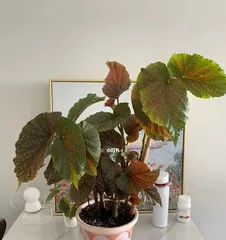Begonia belongs to the Rosaceae family and is a plant that prefers cool and moist environments. Its beautiful flowers and unique form are loved by people. However, to let begonias thrive at home requires some professional knowledge and skills. This article will provide detailed introductions on aspects such as the time for potting and care methods, helping everyone understand the planting and maintenance of begonias, and assisting you in creating a beautiful balcony small garden.

I. Choosing an Appropriate Pot
Before potting, you first need to prepare a suitable pot. Generally, begonias prefer larger pots to allow more space for root growth. At the same time, the pot should be made of materials with good breathability and excellent drainage performance, such as ceramic or plastic.
II. Selecting High-Quality Soil
After selecting the pot, you need to choose high-quality soil. Begonias prefer soil that is loose, fertile, and well-draining. You can appropriately add organic matter such as well-rotted compost to improve soil fertility.

III. Suitable Time for Potting
The best time for potting begonias is usually in spring or autumn. Potting during this period allows the plant to better adapt to the environment and grow quickly. It should be noted that potting operations should not be performed during hot seasons to avoid affecting the growth and development of the plant.
IV. How to Transplant Correctly
Before potting, you need to carefully remove the plant from its original container, making sure to keep the roots intact and avoid damage. Then, place the plant in the new pot and add enough soil. Remember to gently pat the soil to eliminate air bubbles as much as possible.
V. Watering and Fertilizing
Begonias are very sensitive to both water and nutrients. Regular watering and fertilization are needed, but do not overdo it. Usually, watering once a week is sufficient, and fertilization should also be done with appropriate amounts and timing.

VI. Pay Attention to Sunlight and Temperature
Begonia growth requires adequate sunlight and suitable temperatures. In summer, begonias should be provided with sufficient shading measures to prevent strong sunlight and high temperatures from damaging the plants. At the same time, try to maintain an appropriate environmental temperature, avoiding conditions that are too low or too high.
VII. Pruning Timely
Begonias grow quickly, so regular pruning is needed to maintain the plant's aesthetic shape and also promote flower growth.
VIII. Preventing Pests and Diseases
Begonias are relatively susceptible to pests and diseases, requiring regular prevention measures. You can choose environmentally friendly pesticides for spraying, or use natural methods for prevention.
IX. Ensuring Good Ventilation
Begonias need proper air circulation during their growth to maintain healthy plant development. Choose an appropriate location and pay attention to ventilation.
X. Avoid Moving Frequently
Although begonias grow fast, they are sensitive to changes in environment and position. Therefore, avoid moving the plant frequently to prevent affecting its growth.
XI. Regularly Changing Soil
During the growth of begonias, the nutrients in the soil will gradually be depleted, so it is necessary to regularly change the soil to ensure the plant has sufficient nutrients.
XII. Plant Propagation
If you want to expand your begonia collection, you can choose propagation methods such as cuttings or division. This should be done in the appropriate season to obtain more beautiful begonia plants.
XIII. Maintaining a Calm Attitude
Growing and caring for begonias requires experience and skills, but also patience and composure. When encountering problems during the plant's growth, do not panic or become overly nervous; instead, handle the issues calmly.
XIV. It Also Needs Your Care
Begonia is a beautiful and mysterious plant that needs your love and attention. Only when you care for it attentively and give it appropriate affection can it thrive and bloom beautifully.
XV.
Begonia is a beautiful yet challenging plant. Mastering professional knowledge and skills is necessary during the planting and care process. We hope this article's introduction can be helpful to you, assisting you in creating a beautiful balcony small garden.
<|end_of_box|>